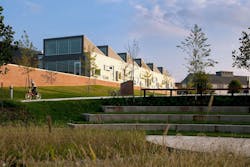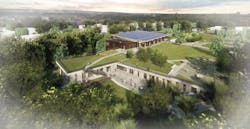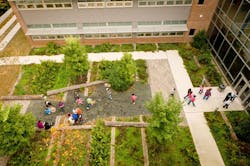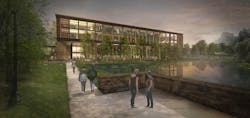The case for public space in the age of COVID-19
By Joe Celentano, AIA, Principal, VMDO Architects
Public spaces are easy to take for granted. They are always there. Backdrops for our social outings, phone conversations, dog walks, and commutes. As our daily footprint narrows under “stay at home” measures, we must reconsider our relationship with public spaces – those parks, green spaces, and trails – that provide incredible health benefits, at a time when one could argue that we need them the most.
Demand for Public Space during COVID-19
With spring and COVID-19 occurring at the same time, we have seen upticks in the use of parks, hiking trails, and other public outdoor spaces for both physical and mental health – much to the dismay of public officials across the country. Data from 31 trails managed by the Rails-to-Trails Conservancy showed that trail usage from March 16 to March 22, overlapping with the first day of spring, increased almost 200 percent in 2020 compared to the same week in 2019.1
Popular hikes in national and state parks across the country are increasingly closing to the public, as overflowing trailheads, beaches, and parking lots undermine social distancing measures and add potential hazards to local jurisdictions already overburdened with the pandemic. Many local jurisdictions are closing local park facilities, which include pavilions, restrooms, and pathways that some of our most vulnerable populations rely on for respite and recreation.
Green Space and Public Health
Up until recently, green spaces and public health were pretty much synonymous – with healthy outdoor spaces begetting healthy citizens, and vice versa. We have seen progress with inclusivity – from ADA accessibility measures to the reframing of monuments in parks. Studies about the benefits of movement, views to nature, and gathering as a form of community-building have ballooned in number. So, what do we do during this time when public spaces are increasingly viewed as counter to public health? Is the best move to not move at all, or should we continue to practice social distancing as best as we can in parks and other recreation areas?
Even the most rigorous “stay at home” orders in the U.S. still allow access to the outdoors and recreation. In some ways, green spaces – when mandates on travel and social distancing are enforced – can be viewed as providing “essential services” by alleviating stress, soothing nerves, and boosting health outcomes, including immunity and sleep. Indeed, park and recreation departments are considered an essential partner in intergovernmental emergency responses occurring across the country.
The Impact of Green Space on Mental Health
What this means for our architectural projects may seem obvious – more green space! – but the association between outdoor space and health has deep roots in human psychology that is worth considering from a developmental perspective. A sweeping 2019 nationwide study of approximately one million people in Denmark found that childhood exposure to green space – forests, parks, hiking trails, etc.– reduces the risk for developing an array of psychiatric disorders during adolescence and adulthood. Specifically, scientists found that “children who grew up with the lowest levels of green space had up to a 55% higher risk of developing a psychiatric disorder independent from other known risk factors.”2
As the largest epidemiological study to date documenting a positive connection between green space and mental health, this research reaffirms what we’ve known all along – that access and views to nature, coupled with immersive learning and sustained exposure to natural settings, serve as effective strategies for enhancing health and wellness. Layered onto this knowledge is now specific evidence that green space-focused planning and design are effective early intervention tools for reducing mental health problems later in life.
Design Strategies
With this research mind, what are some different planning and design strategies that help maximize exposure to nature and its benefits, even during a crisis like we're experiencing? We offer some suggestions below.
1. Design Accessible Sites
Designing sites that are accessible, even when buildings or lots are closed, is a strategy that accommodates public use particularly for surrounding communities. Lubber Run Park and Community Center in Arlington, VA maximizes green space on a tight urban site while offering indoor-outdoor recreation spaces and amenities for the rapidly-growing community. Equal parts landscape and building, the project locates parking and select programming underground to conserve open space for courtyards, pathways, and outdoor amenities, which are accessible to the public after hours. When the Community Center is open to public use, views to nature, dynamic daylighting, and the use of natural materials and biophilic elements create the feeling of being in nature even while inside. The result is an accessible park landscape that supports the health and wellness of community members of all ages.
2. Design Places that Connect to and Engage with Nature
Designing spaces that ground people in a sense of place can create feelings of connectedness that overcome time and distance, especially when we cannot gather together. Manassas Park Elementary School expresses the unique features of a place – nearby Camp Carondelet, used for education, exercise, recreation, and tourism – while assuming the added responsibility of cultivating environmental stewards in the school's community of teachers, learners, and parents. Both the school building and the site are designed to be an expansion and expression of the nearby forest ecosystem while optimizing the relationships between indoors and outdoors, school and community, and culture and ecology. Like Maurice Sendak’s Where the Wild Things Are, the school elicits a sense of imagination, discovery, and wonder through the relationship it creates between a human community and the surrounding woodlands and watersheds.
3. Design for Slowness
The slower pace and smaller radius we're experiencing right now helps us pause, reflect, and appreciate our homes, families, neighborhoods, and communities that are in our immediate vicinity. Bringing this slower sensibility into our design of places helps us remain mindful of our common communities and landscapes, whether human or natural. The new Contemplative Commons at the University of Virginia adheres to the understanding that the mind, body, and nature are deeply interconnected, and that exposure to diverse and authentic natural environments is key to human health, happiness, and productivity. The program, which intentionally bridges traditionally siloed departments at UVA, offers a blend of academic, research, and immersive learning spaces as well as event and mindfulness areas wrapped in a serenity usually reserved for a campus chapel or pristine garden. All of the Commons’ natural spaces are programmable, supportive of research, and open to the public who are welcome to access the site for reflection and relaxation.
Logic would follow that public architecture serves the greatest need when the public can inhabit and commune in its public spaces, and not during a pandemic. Yet, it is precisely during these moments when we realize the essential need for accessible spaces that nourish our physical and mental health. We can take this new appreciation for public spaces and, humanely applying the design strategies above, design better sites and structures that provide essential components for community health.



